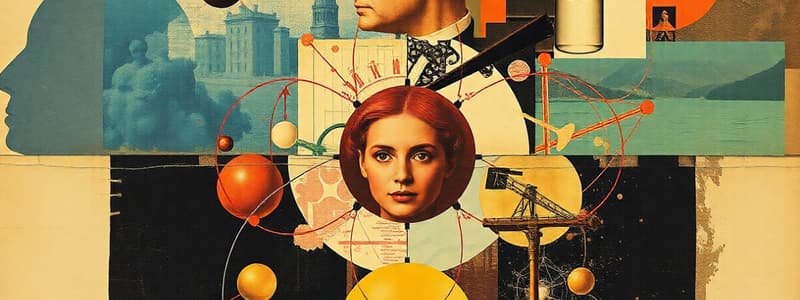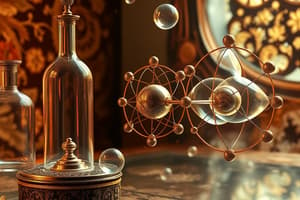Podcast
Questions and Answers
What did Eugen Goldstein experimentally prove in relation to atoms?
What did Eugen Goldstein experimentally prove in relation to atoms?
- The atomic structure as a solid sphere of uniform charges.
- The existence of protons to neutralize electron charges. (correct)
- The existence of electrons as negatively charged particles.
- The existence of neutrons within the nucleus.
What distinguishes anode rays from cathode rays?
What distinguishes anode rays from cathode rays?
- Anode rays can be deflected by magnetic fields while cathode rays cannot.
- Anode rays are formed from positive ions while cathode rays are made of electrons. (correct)
- Anode rays consist of electrons and have a higher velocity than cathode rays.
- Anode rays are negatively charged while cathode rays are positively charged.
What is a characteristic property of anode rays?
What is a characteristic property of anode rays?
- They travel in straight lines and are positively charged. (correct)
- Their q/m ratio is consistent across all gases.
- They travel in curved paths.
- They can be deflected by an electric field.
Which statement best describes Thomson's atomic model?
Which statement best describes Thomson's atomic model?
What was the primary aim of Rutherford’s gold foil experiment?
What was the primary aim of Rutherford’s gold foil experiment?
What particle was primarily used in Rutherford's experiment to investigate the atomic structure?
What particle was primarily used in Rutherford's experiment to investigate the atomic structure?
Which conclusion did Rutherford draw from the observation that most alpha particles passed through the foil without deflection?
Which conclusion did Rutherford draw from the observation that most alpha particles passed through the foil without deflection?
What major aspect of atomic structure was NOT explained by Rutherford's model?
What major aspect of atomic structure was NOT explained by Rutherford's model?
In the planetary model proposed by Rutherford, what does the nucleus represent?
In the planetary model proposed by Rutherford, what does the nucleus represent?
What did Rutherford conclude about the charge of the nucleus?
What did Rutherford conclude about the charge of the nucleus?
According to Rutherford, how do electrons move around the nucleus?
According to Rutherford, how do electrons move around the nucleus?
What fundamental property of atoms does Rutherford's model explain?
What fundamental property of atoms does Rutherford's model explain?
What phenomenon could NOT be explained by Rutherford’s atomic model?
What phenomenon could NOT be explained by Rutherford’s atomic model?
What is the average atomic mass of chlorine (Cl) based on the isotopes provided?
What is the average atomic mass of chlorine (Cl) based on the isotopes provided?
What unit is used to express atomic mass, and how is it defined?
What unit is used to express atomic mass, and how is it defined?
How is the average atomic mass of an element determined?
How is the average atomic mass of an element determined?
What is the contribution of the isotope carbon-13 to the average atomic mass of carbon based on its abundance?
What is the contribution of the isotope carbon-13 to the average atomic mass of carbon based on its abundance?
If an isotope of carbon has an atomic mass of 14 amu and an abundance of 0.01%, what is its contribution to the average atomic mass calculation?
If an isotope of carbon has an atomic mass of 14 amu and an abundance of 0.01%, what is its contribution to the average atomic mass calculation?
What did Democritus propose about matter?
What did Democritus propose about matter?
Which of the following statements best represents Aristotle's view on matter?
Which of the following statements best represents Aristotle's view on matter?
What is the nature of the particles in cathode rays?
What is the nature of the particles in cathode rays?
What is NOT one of Dalton's major postulates?
What is NOT one of Dalton's major postulates?
Who discovered the electron and in what year?
Who discovered the electron and in what year?
How did J.J. Thomson determine the charge-to-mass ratio of the cathode ray particles?
How did J.J. Thomson determine the charge-to-mass ratio of the cathode ray particles?
According to Dalton’s Atomic Theory, how are compounds formed?
According to Dalton’s Atomic Theory, how are compounds formed?
What is the charge of an electron as found by Millikan?
What is the charge of an electron as found by Millikan?
What was the main flaw in Democritus's atomic theory?
What was the main flaw in Democritus's atomic theory?
Which of the following statements about cathode rays is incorrect?
Which of the following statements about cathode rays is incorrect?
Which of the following was NOT a belief held by early philosophers regarding the nature of matter?
Which of the following was NOT a belief held by early philosophers regarding the nature of matter?
What is the charge-to-mass ratio (e/m) of the cathode ray particle as measured by J.J. Thomson?
What is the charge-to-mass ratio (e/m) of the cathode ray particle as measured by J.J. Thomson?
In the Millikan Oil Drop Experiment, which equation is used to relate the electric field and force on the oil droplet?
In the Millikan Oil Drop Experiment, which equation is used to relate the electric field and force on the oil droplet?
Which concept comes closest to the modern understanding of atomic structure?
Which concept comes closest to the modern understanding of atomic structure?
Which of these properties is NOT a characteristic of cathode rays?
Which of these properties is NOT a characteristic of cathode rays?
What was the primary significance of Millikan's findings regarding the charge of the electron?
What was the primary significance of Millikan's findings regarding the charge of the electron?
What was the purpose of placing a paddle wheel behind the Beryllium nucleus during Chadwick's experiment?
What was the purpose of placing a paddle wheel behind the Beryllium nucleus during Chadwick's experiment?
Why were the undevoted radiations initially thought to be electromagnetic radiation?
Why were the undevoted radiations initially thought to be electromagnetic radiation?
How are isotopes defined?
How are isotopes defined?
What did Chadwick conclude about the particles he discovered?
What did Chadwick conclude about the particles he discovered?
What is the atomic weight of an element defined as?
What is the atomic weight of an element defined as?
What happens when neutrons are introduced into the atomic nucleus?
What happens when neutrons are introduced into the atomic nucleus?
Which of the following statements is true regarding protons and neutrons?
Which of the following statements is true regarding protons and neutrons?
What was the key observation that led to the discovery of neutrons?
What was the key observation that led to the discovery of neutrons?
Flashcards
Democritus' Atomic Theory
Democritus' Atomic Theory
The idea that matter is made up of indivisible particles called atoms, proposed by Democritus in ancient Greece.
Aristotle's Theory of Matter
Aristotle's Theory of Matter
A theory that matter is composed of four elements: fire, dust, water, and air in different proportions, proposed by Aristotle.
Dalton's Atomic Theory
Dalton's Atomic Theory
The theory that elements are made up of atoms that cannot be divided, with atoms of different elements having different masses.
Electron
Electron
Signup and view all the flashcards
What are anode rays?
What are anode rays?
Signup and view all the flashcards
How are anode rays produced?
How are anode rays produced?
Signup and view all the flashcards
What are the properties of anode rays?
What are the properties of anode rays?
Signup and view all the flashcards
What is Thomson's Atomic Model?
What is Thomson's Atomic Model?
Signup and view all the flashcards
How did Rutherford's experiment disprove Thomson's model?
How did Rutherford's experiment disprove Thomson's model?
Signup and view all the flashcards
Cathode Ray Experiment
Cathode Ray Experiment
Signup and view all the flashcards
Cathode Rays in Electric Field
Cathode Rays in Electric Field
Signup and view all the flashcards
Properties of Cathode Ray Particles
Properties of Cathode Ray Particles
Signup and view all the flashcards
Charge/Mass Ratio of Electron (e/m)
Charge/Mass Ratio of Electron (e/m)
Signup and view all the flashcards
Millikan Oil Drop Experiment
Millikan Oil Drop Experiment
Signup and view all the flashcards
Charge of Electron
Charge of Electron
Signup and view all the flashcards
Mass of Electron
Mass of Electron
Signup and view all the flashcards
Importance of Electron
Importance of Electron
Signup and view all the flashcards
What is the average atomic mass of an element?
What is the average atomic mass of an element?
Signup and view all the flashcards
What is an Atomic Mass Unit (amu)?
What is an Atomic Mass Unit (amu)?
Signup and view all the flashcards
How is the atomic mass of an element calculated?
How is the atomic mass of an element calculated?
Signup and view all the flashcards
Why is Carbon-12 (12C) used as the standard for atomic mass units?
Why is Carbon-12 (12C) used as the standard for atomic mass units?
Signup and view all the flashcards
How to calculate Chlorine's atomic mass?
How to calculate Chlorine's atomic mass?
Signup and view all the flashcards
What would be the mass ratio of helium to hydrogen?
What would be the mass ratio of helium to hydrogen?
Signup and view all the flashcards
Who discovered the neutron?
Who discovered the neutron?
Signup and view all the flashcards
How were neutrons discovered?
How were neutrons discovered?
Signup and view all the flashcards
What is the atomic number?
What is the atomic number?
Signup and view all the flashcards
What is the mass number?
What is the mass number?
Signup and view all the flashcards
What are isotopes?
What are isotopes?
Signup and view all the flashcards
Give an example of isotopes.
Give an example of isotopes.
Signup and view all the flashcards
What is atomic weight?
What is atomic weight?
Signup and view all the flashcards
What did the alpha particles' straight paths through the gold foil indicate?
What did the alpha particles' straight paths through the gold foil indicate?
Signup and view all the flashcards
What did the deflection of some alpha particles at small angles suggest about the atom?
What did the deflection of some alpha particles at small angles suggest about the atom?
Signup and view all the flashcards
What did the deflection of some alpha particles at large angles indicate about the atom?
What did the deflection of some alpha particles at large angles indicate about the atom?
Signup and view all the flashcards
What did Rutherford's model of the atom propose?
What did Rutherford's model of the atom propose?
Signup and view all the flashcards
What did Rutherford's experiment reveal about the size of the nucleus relative to the entire atom?
What did Rutherford's experiment reveal about the size of the nucleus relative to the entire atom?
Signup and view all the flashcards
What was a major drawback of Rutherford's model?
What was a major drawback of Rutherford's model?
Signup and view all the flashcards
What other limitations did Rutherford's model have?
What other limitations did Rutherford's model have?
Signup and view all the flashcards
What is another shortcoming of Rutherford's planetary model?
What is another shortcoming of Rutherford's planetary model?
Signup and view all the flashcards
Study Notes
Inorganic Chemistry - Lecture Notes
- Course title: Inorganic Chemistry
- University: Ain Shams University
- Department: Chemistry
- Year: 2022-2023
Lecture 1: History of the Atom (Theories & Models)
-
Key figures and associated dates:
- Democritus (460 B.C.): Proposed the concept of atoms
- Dalton (1803): Introduced the atomic theory with four key points.
- Thomson (1897): Discovered the electron.
- Rutherford (1912): Discovered the nucleus of the atom.
- Bohr (1913): Proposed the planetary model of the atom.
- Modern Atomic Theory (1930): Further refinement of atomic models.
-
Democritus’ ideas: Matter is made of indivisible particles called atoms.
-
Aristotle’s idea: Matter is made up of four elements (fire, dust, water and air).
-
Dalton’s atomic theory points: Elements consist of tiny particles called atoms; atoms of the same element have similar mass; atoms combine in simple ratios to form compounds; and atoms are indivisible.
Lecture 2: Discovery of the Electron
-
Discovery: Joseph John Thomson discovered the electron in 1897 while studying cathode rays.
-
Cathode ray experiment: The experiment involves a discharge tube with a cathode and anode, and a high voltage. An invisible ray is emitted from the cathode, causing a fluorescent glow on the tube wall. This is indicative of particles.
-
Electric field experiment (using cathode rays): These particles are deflected in presence of an electric field. This indicates that they are negatively charged particles.
Lecture 3: Charge/Mass Ratio of Electron; Millikan Oil Drop Experiment
-
J. J. Thomson's measurement: He determined the relative charge-to-mass ratio (e/m) of the electron using electric and magnetic fields.
-
Millikan's experiment: This experiment determined the charge of an electron (e) with the help of oil drops and an electric field.
Lecture 4: Anode Rays (Canal Rays) and Rutherford Experiment
-
Anode rays: Positively charged particles emitted from the anode in a discharge tube - discovered by Eugen Goldstein.
-
Rutherford's experiment: The experiment involved shooting high-energy alpha particles at a thin gold foil. This experiment led to the discovery of the nucleus in the atom.
-
Rutherford's conclusions:
- Most alpha particles pass through the gold foil undeflected, suggesting mostly empty space within the atom.
- Some alpha particles are deflected at small angles, implying the presence of a concentrated positive charge in the atom.
- Very few alpha particles are deflected almost completely or rebound, revealing a very densely packed, positively charged center (the nucleus) within the atom.
Lecture 5: Rutherford's Model & Atomic Stability Discussion
-
Rutherford's model: It explained the atom's structure as a small, dense, positively charged nucleus surrounded by electrons.
-
Stability issues: Rutherford’s model explained the atom's structure but had issues explaining the stability of the atom. The electrons orbiting the nucleus would lose energy and spiral into the nucleus, which would result in the atom collapsing.
Lecture 6- 7: Extra Mass, Discovery of Neutrons, Atomic Number and Mass Number, and Isotopes
-
Extra mass: Atoms of different elements have different numbers of protons, leading to different nuclear charges. This extra mass is due to the presence of neutrons.
-
Neutron discovery: Chadwick's experiment bombarded Beryllium with alpha particles, discovering neutrons (neutral particles) within the atom.
-
Atomic number (Z): The number of protons in an atom's nucleus.
-
Mass number (A): The total number of protons and neutrons in an atom's nucleus.
-
Isotopes: Atoms of the same element with the same number of protons (atomic number) but a different number of neutrons (different mass number).
Lecture 8: Hydrogen and Carbon Isotopes, Oxygen Isotopes, Atomic Mass, Atomic Mass Unit, and Naturally Occurring Isotopes of Neon.
-
Hydrogen Isotopes (Protium, Deuterium, Tritium): Examples of isotopes differing only in their neutron count
-
Carbon Isotopes (Carbon-12, Carbon-13, Carbon-14): Examples of isotopes of Carbon.
-
Oxygen Isotopes: Examples of isotopes of Oxygen.
-
Atomic mass: Represents the average mass of an element's naturally occurring isotopes.
-
Atomic mass unit (amu): A unit for expressing the relative masses of atoms, based on one-twelfth the mass of a carbon-12 atom.
-
Naturally Occurring Isotopes of Neon: Neon-20, Neon-21, and Neon-22, with differing abundances.
Studying That Suits You
Use AI to generate personalized quizzes and flashcards to suit your learning preferences.




